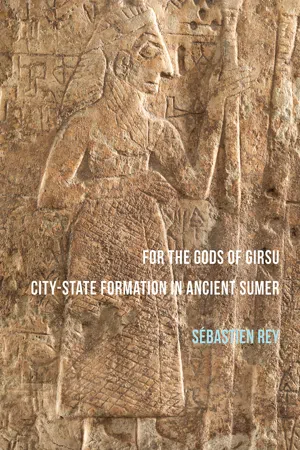
- 84 pages
- English
- PDF
- Available on iOS & Android
For the Gods of Girsu: City-State Formation in Ancient Sumer
About this book
For the Gods are the opening words or incipit of the first inscribed votive artefacts dedicated to the principal deities of the Sumerian pantheon. They commemorate the construction or renovation of cities, temples, rural sanctuaries, border steles, in sum all the symbolically charged features of archaic states belonging thus metaphorically to supernatural tutelary overlords. Girsu (present-day Tello) is one of the earliest known cities of the world together with Uruk, Eridu, and Ur, and was considered to be in the 3rd Millennium the sanctuary of the Sumerian heroic god Ningirsu who fought with the demons of the Kur (Mountain) and thus made possible the introduction of irrigation and agriculture in Sumer. Girsu was the sacred metropolis and central pole of a city-state that lay in the Southeasternmost part of the Mesopotamian floodplain. The pioneering explorations carried out between 1877 and 1933 at Tello and the early decipherment of the Girsu cuneiform tablets were ground-breaking because they revealed the principal catalytic elements of the Sumerian takeoff – that is, a multiplicity and coalescence of major innovations, such as the appearance of a city– countryside continuum, the emergence of literacy, of bronze manufacture, and the development of monumental art and architecture. Because of the richness of information related in particular to the city's spatial organization and geographical setting, and thanks to the availability of recently declassified Cold War space imagery and especially the possibility to launch new explorations in Southern Iraq, Girsu stands out as a primary locale for re-analyzing through an interdisciplinary approach combining archaeological and textual evidence the origins of the Sumerian city-state.
Frequently asked questions
- Essential is ideal for learners and professionals who enjoy exploring a wide range of subjects. Access the Essential Library with 800,000+ trusted titles and best-sellers across business, personal growth, and the humanities. Includes unlimited reading time and Standard Read Aloud voice.
- Complete: Perfect for advanced learners and researchers needing full, unrestricted access. Unlock 1.4M+ books across hundreds of subjects, including academic and specialized titles. The Complete Plan also includes advanced features like Premium Read Aloud and Research Assistant.
Please note we cannot support devices running on iOS 13 and Android 7 or earlier. Learn more about using the app.
Information
Table of contents
- Cover
- Title Page
- Copyright Page
- Contents
- List of Figures
- Foreword
- Introduction: Concept of the Sumerian City-State
- Once Upon a Time in Ancient Girsu. Or Tello and the Rediscovery of the Sumerians
- Fig. 1: The Tower of Babel by Bruegel the Elder
- Fig. 2: Ernest de Sarzec and his escort at Tello
- Fig. 3: Apotropaic pillar composed of inscribed bricks from Gudea
- Fig. 4: Stele of the Vultures. Mythological side depicting the heroic war-god Ningirsu and the tempest-bird Imdugud
- Fig. 5: Spatial organization of the sacred precinct of Girsu
- The City of the Heroic God. The General Layout of a Sumerian Metropolis
- Fig. 6: The central complex of mounds of Tello (Tell K, Tell I-I’)
- Fig. 7: Superimposed 1968 Corona space photography of Tello
- Fig. 8: Principal topographical features and quarters of ancient Girsu revealed by the 1968 Corona satellite imagery, including the sacred-city Iri-ku3 (A), the central and southern areas (B), the eastern extramural district (C), the peripheral tells and
- Fig. 9: Schematic plan of the Early Dynastic defended gate of the mound of the Porte du Diable (Tell P-P’), either A-bul5-la-dBa-U2 or A-bul5-la-dNin-g̃ir2-su, featuring
- Fig. 10: Schematic plan of the Early Dynastic religious complex of Ningirsu
- Fig. 11: Mace of Me-salim of Kiš recording the earliest known ruler of Lagaš Lugal-ša-engur
- Fig. 12: Artistic view of the Early Dynastic temple of Ningirsu,
- Fig. 13: The so-called Enigmatic construction of the Eastern tells, in fact a bridge over a paleo-channel (April 2015).
- Fig. 14: Modern high resolution space photography of Tello
- Fig. 15: General layout and topographical features of the Early Dynastic religious megapolis of Girsu reconstructed by combini g archaeological and textual evidence and satellite imagery, and confirmed in April and November 2015 by ground reconnaissance:
- Chapter Three: The Girsu Countryside. The Spatial Organization of a Sumerian City-State
- Fig. 16: The immediate hinterlands of Girsu. Archaeological mounds of Tello are detectable in the background (November 2015).
- Fig. 17: Superimposed 1968 Corona space photography of Southern Babylonia with the T. Jacobsen 1969 map of Early Dynastic sites, canals, and ancient rivers in the Girsu region
- Fig. 18: Map of the Early Dynastic settlement pattern of the Girsu-Lagaš city-state highlighting (A) the region around Girsu, (B) the Lagaš neighborhood, (C) the Nig̃en district, (D) the Gu’abba area, and (E) the Gu’edena border.
- Fig. 19: Map of the Early Dynastic network of watercourses and marshlands of the
- Fig. 20: Reconstruction of the Early Dynastic ritual procession-ways of the Girsu-Lagaš city-state from offering lists recordi g libations and sacrifices for the gods Ningirsu, Nanše, and Ba’u.
- Fig. 21: General view of the sacred precinct of Girsu (November 2015)
- Fig. 22: The Early Dynastic ceremonial plaza of the sacred precinct of Girsu
- Fig. 23: Early Dynastic III ceremonial terracotta vessels from Area A
- Chapter Four: Demarcated by the Gods. Sumerian Rites and the Lagaš-Umma Border Conflict
- Fig. 24: The Early Dynastic Sumerian alluvium featuring the Gu’edena frontier between
- Fig. 25: Stele of the Vultures.
- Fig. 26: Reconstruction of the Lugal-zagesi campaign against Lagaš
- Conclusion: Morphogenesis of an Archaic City-State
- Fig. 27: Archaic bas-relief of the Figure aux plumes recording the earliest known occurrence of the sanctuary of Ningirsu (E2-dNin-g̃ir2-su).
- Bibliography